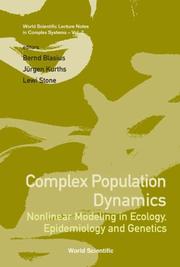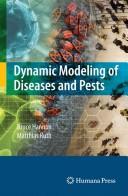| Listing 1 - 10 of 14 | << page >> |
Sort by
|
Book
ISBN: 3540559043 0387559043 Year: 1992 Publisher: Berlin New York Springer-Verlag
Abstract | Keywords | Export | Availability | Bookmark
 Loading...
Loading...Choose an application
- Reference Manager
- EndNote
- RefWorks (Direct export to RefWorks)
Book
ISBN: 0192617451 9780192617453 Year: 1988 Volume: vol *21 Publisher: Oxford New York Tokyo Oxford University Press
Abstract | Keywords | Export | Availability | Bookmark
 Loading...
Loading...Choose an application
- Reference Manager
- EndNote
- RefWorks (Direct export to RefWorks)
Biomathematics. Biometry. Biostatistics --- Mathematical statistics --- AIDS (Disease) --- Epidemiology --- Statistical methods --- Congresses. --- Mathematical models --- Congresses --- AIDS (Disease) - Epidemiology - Statistical methods - Congresses. --- AIDS (Disease) - Epidemiology - Mathematical models - Congresses

ISBN: 3540565264 0387565264 3540705147 Year: 1993 Volume: 97 Publisher: Berlin ; New York ; Paris Springer
Abstract | Keywords | Export | Availability | Bookmark
 Loading...
Loading...Choose an application
- Reference Manager
- EndNote
- RefWorks (Direct export to RefWorks)
Epidemiologic Methods --- Models, Theoretical --- Epidemiology --- Epidémiologie --- Mathematical models --- Modèles mathématiques --- Epidémiologie --- Modèles mathématiques --- Epidemiologic Methods. --- Models, Theoretical. --- Epidemiology - Mathematical models.

ISBN: 128191178X 9786611911782 9812771581 9789812771582 9789812771575 9812771573 Year: 2007 Volume: 7 Publisher: Hackensack, NJ World Scientific
Abstract | Keywords | Export | Availability | Bookmark
 Loading...
Loading...Choose an application
- Reference Manager
- EndNote
- RefWorks (Direct export to RefWorks)
"This collection of review articles is devoted to the modeling of ecological, epidemiological and evolutionary systems. Theoretical mathematical models are perhaps one of the most powerful approaches available for increasing our understanding of the complex population dynamics in these natural systems. Exciting new techniques are currently being developed to meet this challenge, such as generalized or structural modeling, adaptive dynamics or multiplicative processes. Many of these new techniques stem from the field of nonlinear dynamics and chaos theory, where even the simplest mathematical rule can generate a rich variety of dynamical behaviors that bear a strong analogy to biological populations."
Population biology --- Ecology --- Epidemiology --- Genetics --- Biomathematics --- Mathematical models. --- Mathematical models --- mathematical models --- Population biology - Mathematical models --- Ecology - Mathematical models --- Epidemiology - mathematical models --- Genetics - Mathematical models
Book
ISBN: 1461457181 1489994947 146145719X 1283934280 Year: 2013 Publisher: New York : Springer,
Abstract | Keywords | Export | Availability | Bookmark
 Loading...
Loading...Choose an application
- Reference Manager
- EndNote
- RefWorks (Direct export to RefWorks)
Infectious Diseases: Selected Entries from the Encyclopedia of Sustainability Science and Technology presents authoritative, peer-reviewed contributions from leading experts on a wide range of major infectious diseases of global importance. Infectious diseases account for more than 17 million deaths each year worldwide. While modern medicine and technology have diminished the threat of many of these pathogens in high-income countries, the ever present threats of re-emerging infections, population mobility, natural disasters, and pathogen genetic variability are but some of the reasons for the dynamic threat of this broad category of risks to human health. An indispensable resource for students and scientists, the volume also covers some of the new technologies currently under development for infectious disease prevention, treatment, and eradication. The greater part of the infectious disease burden remains in the tropics, where low and middle-income countries lack the resources, infrastructure, and health systems to mount or sustain control efforts. Many contributions describe the efforts of the scientific research community and international donor agencies to achieve the integrated goals of vigilant surveillance, improved and cost-effective diagnostics, and treatment for sustainable disease control. Describes the dynamic nature of infectious disease agents and their complex interactions with the environment and their human and animal hosts Covers new technologies for antibiotics, vaccines, and treatment Features several contributions on waterborne infectious diseases, including enteric viruses and bacterial pathogens in the ocean Provides an excellent introduction for those entering the field, as well as new insights for advanced researchers and industry experts.
Communicable diseases -- Mathematical models. --- Epidemiology -- Mathematical models -- Congresses. --- Epidemiology -- Mathematical models. --- Communicable diseases --- Infection --- Bacterial Infections and Mycoses --- Diseases --- Communicable Diseases, Emerging --- Communicable Diseases --- Medicine --- Health & Biological Sciences --- Infectious Diseases --- Communicable diseases. --- Contagion and contagious diseases --- Contagious diseases --- Infectious diseases --- Microbial diseases in human beings --- Zymotic diseases --- Medicine. --- Environmental health. --- Vaccines. --- Public health. --- Infectious diseases. --- Epidemiology. --- Marine sciences. --- Freshwater. --- Medicine & Public Health. --- Infectious Diseases. --- Water and Health. --- Marine & Freshwater Sciences. --- Vaccine. --- Public Health. --- Epidemics --- Emerging infectious diseases. --- Marine Sciences. --- Public health --- Biologicals --- Ocean sciences --- Aquatic sciences --- Emerging infections --- New infectious diseases --- Re-emerging infectious diseases --- Reemerging infectious diseases --- Community health --- Health services --- Hygiene, Public --- Hygiene, Social --- Public health services --- Public hygiene --- Social hygiene --- Health --- Human services --- Biosecurity --- Health literacy --- Medicine, Preventive --- National health services --- Sanitation --- Fresh waters --- Freshwater --- Freshwaters --- Inland water --- Inland waters --- Water --- Environmental quality --- Health ecology --- Environmental engineering --- Health risk assessment --- Health aspects --- Environmental aspects
Book
ISBN: 0852642318 9780852642313 Year: 1975 Publisher: London High Wycombe : C. Griffin,
Abstract | Keywords | Export | Availability | Bookmark
 Loading...
Loading...Choose an application
- Reference Manager
- EndNote
- RefWorks (Direct export to RefWorks)
Biomathematics. Biometry. Biostatistics --- Epidemiology --- Mathematical statistics --- Infectious diseases. Communicable diseases --- mathematical models --- Mathematics. --- Communicable Diseases. --- Biometry. --- Epidemiology. --- 519.218 --- Disease --- Anthropology, Physical --- Statistics as Topic --- Infectious Diseases --- Communicable Disease --- Disease, Communicable --- Disease, Infectious --- Diseases, Communicable --- Diseases, Infectious --- Infectious Disease --- Disease Outbreaks --- Disease Transmission, Infectious --- Mathematic --- Special stochastic processes --- epidemiology --- Mathematical models. --- 519.218 Special stochastic processes --- Biometry --- Communicable Diseases --- Mathematics --- Mathematical models --- Social Epidemiology --- Epidemiologies, Social --- Epidemiology, Social --- Social Epidemiologies --- Epidemiology - mathematical models --- Biomathematique --- Maladies infectieuses --- Infectious diseases --- Mathematical methods
Book
ISBN: 3540068961 364296222X 3642962203 0387068961 9780387068961 9783540068969 Year: 1974 Publisher: Berlin : Springer-Verlag,
Abstract | Keywords | Export | Availability | Bookmark
 Loading...
Loading...Choose an application
- Reference Manager
- EndNote
- RefWorks (Direct export to RefWorks)
Biomathematics. Biometry. Biostatistics --- Phytopathology. Phytoparasitology --- Epidemiology. --- Models, Theoretical. --- Plant Diseases. --- Disease, Plant --- Diseases, Plant --- Plant Disease --- Disease --- epidemiology --- Experimental Model --- Experimental Models --- Mathematical Model --- Model, Experimental --- Models (Theoretical) --- Models, Experimental --- Models, Theoretic --- Theoretical Study --- Mathematical Models --- Model (Theoretical) --- Model, Mathematical --- Model, Theoretical --- Models, Mathematical --- Studies, Theoretical --- Study, Theoretical --- Theoretical Model --- Theoretical Models --- Theoretical Studies --- Computer Simulation --- Systems Theory --- Social Epidemiology --- Epidemiologies, Social --- Epidemiology, Social --- Social Epidemiologies --- Epidemiology --- Models, Theoretical --- Plant Diseases --- Plant diseases - Epidemiology --- Epidemiology - Mathematical models
Book
ISBN: 146141685X 1461416868 9781461416852 Year: 2012 Publisher: New York, NY : Springer New York : Imprint: Springer,
Abstract | Keywords | Export | Availability | Bookmark
 Loading...
Loading...Choose an application
- Reference Manager
- EndNote
- RefWorks (Direct export to RefWorks)
This textbook provides an introduction to the field of mathematical biology through the integration of classical applications in ecology with more recent applications to epidemiology, particularly in the context of spread of infectious diseases. It integrates modeling, mathematics, and applications in a semi-rigorous way, stating theoretical results and giving references but not necessarily giving detailed proofs, providing a solid introduction to the field to undergraduates (junior and senior level), graduate students in applied mathematics, ecology, epidemiology or evolutionary biology, sustainability scientists, and to researchers who must routinely read the practical and theoretical results that come from modeling in ecology and epidemiology. This new edition has been updated throughout. In particular the chapters on epidemiology have been updated and extended considerably, and there is a new chapter on spatially structured populations that incorporates dispersal. The number of problems has been increased and the number of projects has more than doubled, in particular those stressing connections to data. In addition some examples, exercises, and projects include use of Maple and Matlab. Review of first edition: "A strength of the book is the large number of biologically-motivated problem sets. These and the references to the original biological papers would be valuable resources for an instructor." (UK Nonlinear News, 2001).
Epidemiology -- Mathematical models. --- Population biology -- Mathematical models. --- Population biology --- Epidemiology --- Biology --- Health & Biological Sciences --- Biology - General --- Mathematical models --- Mathematical models. --- Mathematics. --- Community ecology, Biotic. --- Biomathematics. --- Mathematical and Computational Biology. --- Community & Population Ecology. --- Ecology. --- Balance of nature --- Bionomics --- Ecological processes --- Ecological science --- Ecological sciences --- Environment --- Environmental biology --- Oecology --- Environmental sciences --- Ecology --- Modelización (4194220) --- Bibliografía recomendada --- Biocenoses --- Biocoenoses --- Biogeoecology --- Biological communities --- Biomes --- Biotic community ecology --- Communities, Biotic --- Community ecology, Biotic --- Ecological communities --- Ecosystems --- Natural communities --- Mathematics
Book
ISBN: 1282458086 1282935917 9786612935916 9786612458088 1400831709 069112132X 0750939753 9781400831708 9780691121321 Year: 2009 Publisher: Princeton, NJ
Abstract | Keywords | Export | Availability | Bookmark
 Loading...
Loading...Choose an application
- Reference Manager
- EndNote
- RefWorks (Direct export to RefWorks)
The 1918-19 influenza epidemic killed more than fifty million people worldwide. The SARS epidemic of 2002-3, by comparison, killed fewer than a thousand. The success in containing the spread of SARS was due largely to the rapid global response of public health authorities, which was aided by insights resulting from mathematical models. Models enabled authorities to better understand how the disease spread and to assess the relative effectiveness of different control strategies. In this book, Lisa Sattenspiel and Alun Lloyd provide a comprehensive introduction to mathematical models in epidemiology and show how they can be used to predict and control the geographic spread of major infectious diseases. Key concepts in infectious disease modeling are explained, readers are guided from simple mathematical models to more complex ones, and the strengths and weaknesses of these models are explored. The book highlights the breadth of techniques available to modelers today, such as population-based and individual-based models, and covers specific applications as well. Sattenspiel and Lloyd examine the powerful mathematical models that health authorities have developed to understand the spatial distribution and geographic spread of influenza, measles, foot-and-mouth disease, and SARS. Analytic methods geographers use to study human infectious diseases and the dynamics of epidemics are also discussed. A must-read for students, researchers, and practitioners, no other book provides such an accessible introduction to this exciting and fast-evolving field.
Communicable Diseases - epidemiology. --- Communicable diseases - Epidemiology - Mathematical models. --- Communicable diseases -- Epidemiology -- Mathematical models. --- Communicable Diseases -- epidemiology. --- Communicable Diseases - transmission. --- Communicable Diseases -- transmission. --- Disease Outbreaks - statistics & numerical data. --- Disease Outbreaks -- statistics & numerical data. --- Epidemiologic Methods. --- Epiemiologic Methods. --- Models, Theoretical. --- Communicable diseases --- Epidemiology --- Epidemiologic Methods --- Communicable Diseases --- Disease Outbreaks --- Models, Theoretical --- Infection --- Public Health --- Investigative Techniques --- Analytical, Diagnostic and Therapeutic Techniques and Equipment --- Bacterial Infections and Mycoses --- Medicine --- Environment and Public Health --- Health Occupations --- Diseases --- Health Care --- Disciplines and Occupations --- Health & Biological Sciences --- Mathematical models --- Public health. --- Mathematical models. --- Community health --- Health services --- Hygiene, Public --- Hygiene, Social --- Public health services --- Public hygiene --- Sanitary affairs --- Social hygiene --- Contagion and contagious diseases --- Contagious diseases --- Infectious diseases --- Microbial diseases in human beings --- Zymotic diseases --- Epidemics --- statistics & numerical data. --- transmission. --- epidemiology. --- Epidemiologic Method --- Epidemiological Methods --- Methods, Epidemiologic --- Epidemiological Method --- Method, Epidemiologic --- Method, Epidemiological --- Methods, Epidemiological --- Experimental Model --- Experimental Models --- Mathematical Model --- Model, Experimental --- Models (Theoretical) --- Models, Experimental --- Models, Theoretic --- Theoretical Study --- Mathematical Models --- Model (Theoretical) --- Model, Mathematical --- Model, Theoretical --- Models, Mathematical --- Studies, Theoretical --- Study, Theoretical --- Theoretical Model --- Theoretical Models --- Theoretical Studies --- Computer Simulation --- Systems Theory --- methods --- Health --- Human services --- Biosecurity --- Health literacy --- Medicine, Preventive --- National health services --- Sanitation --- Disease outbreaks --- Outbreaks of disease --- Pestilences --- Communicable disease transmission --- Disease transmission --- Germs, Spread of --- Spread of communicable diseases --- Spread of germs --- Transmission of diseases --- Outbreaks --- Transmission --- Pandemics --- Epiemiologic Methods --- epidemiology --- transmission --- statistics & numerical data --- Communicable diseases - Epidemiology - Mathematical models --- Communicable Diseases - epidemiology --- Communicable Diseases - transmission --- Disease Outbreaks - statistics & numerical data --- Wuhan virus. --- Wuhan. --- coronavirus precautions. --- coronavirus symptoms. --- coronavirus usa cases. --- coronavirus. --- mers. --- sars. --- wuhan coronavirus sequence.

ISBN: 0387095594 0387095608 3540095594 3540348522 Year: 2009 Publisher: New York, NY : Springer New York : Imprint: Springer,
Abstract | Keywords | Export | Availability | Bookmark
 Loading...
Loading...Choose an application
- Reference Manager
- EndNote
- RefWorks (Direct export to RefWorks)
Models help us understand the nonlinear dynamics of real-world processes by using the computer to mimic the actual forces that result in a system’s behavior. The growing complexity of human social systems, from individual behavior to that of entire populations makes us increasingly vulnerable to diseases and pests. The ecology of the disease agents and the pests when considered in this social context only adds to the complexity. The feedbacks, lags in the effects of our preventive actions and the randomness in the environment make understanding of these vulnerabilities seem insurmountable. The amount and pace of modern travel provides virus and pest alike with the means to quickly find new hosts in untouched human populations and the ecosystems. We thus have compelling reasons to understand the dynamics of these combined systems. This book begins with simple examples of human epidemics and then insect dynamics. Next comes the models of ever more complex models of disease carried by interaction of the two. An invasive species model is followed by insect-ecosystem interactions. The general models of chaos and catastrophe are linked to models of disease and pest. The final model is a spatial dynamic spread of disease among a wild animal population. By using the STELLA programs (runtime versions and digital forms of all models are available with the book) we show how with a minimum of mathematical preparation and programming experience, these complex processes can be simulated and their emergent properties discovered. The programs run on both Macintosh and PC based machines.
Communicable diseases -- Epidemiology -- Mathematical models. --- Communicable diseases in animals -- Mathematical models. --- Electronic books. -- local. --- Insects -- Diseases -- Epidemiology -- Mathematical models. --- Insects as carriers of disease --- Epidemics --- Communicable diseases --- Insect Vectors --- Models, Theoretical --- Investigative Techniques --- Arthropod Vectors --- Disease Vectors --- Analytical, Diagnostic and Therapeutic Techniques and Equipment --- Disease Transmission, Infectious --- Public Health --- Environment and Public Health --- Health Care --- Infectious Diseases --- Transmission of Disease --- Communicable Diseases --- Medicine --- Health & Biological Sciences --- Mathematical models --- Epidemiology --- Insects --- Communicable diseases in animals --- Diseases --- Mathematical models. --- Epizootic diseases --- Microbial diseases in animals --- Contagion and contagious diseases --- Contagious diseases --- Infectious diseases --- Microbial diseases in human beings --- Zymotic diseases --- Hexapoda --- Insecta --- Pterygota --- Medicine. --- Health informatics. --- Infectious diseases. --- Epidemiology. --- Computer simulation. --- Bioinformatics. --- Computational biology. --- Medicine & Public Health. --- Health Informatics. --- Simulation and Modeling. --- Infectious Diseases. --- Medicine/Public Health, general. --- Computer Appl. in Life Sciences. --- 511 --- 511 Number theory --- Number theory --- Animals --- Veterinary epidemiology --- Veterinary microbiology --- Infection --- Arthropoda --- Entomology --- Congresses. --- Medical records --- Emerging infectious diseases. --- Biology --- Data processing. --- Clinical sciences --- Medical profession --- Human biology --- Life sciences --- Medical sciences --- Pathology --- Physicians --- Emerging infections --- New infectious diseases --- Re-emerging infectious diseases --- Reemerging infectious diseases --- Computer modeling --- Computer models --- Modeling, Computer --- Models, Computer --- Simulation, Computer --- Electromechanical analogies --- Simulation methods --- Model-integrated computing --- Public health --- EHR systems --- EHR technology --- EHRs (Electronic health records) --- Electronic health records --- Electronic medical records --- EMR systems --- EMRs (Electronic medical records) --- Information storage and retrieval systems --- Medical care --- Health Workforce --- Bioinformatics . --- Computational biology . --- Bioinformatics --- Bio-informatics --- Biological informatics --- Information science --- Computational biology --- Systems biology --- Clinical informatics --- Health informatics --- Medical information science --- Data processing --- Nombres, Théorie des
| Listing 1 - 10 of 14 | << page >> |
Sort by
|

 Search
Search Feedback
Feedback About UniCat
About UniCat  Help
Help News
News